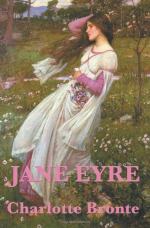|
|
Jane Eyre Author/Context
Charlotte Bronte (1816-55), was the daughter of Patrick Bronte, an Irishman and curate in Yorkshire for over forty years. Many of the facts within Jane Eyre, are biographical. Charlotte's mother died in 1821, which left five daughters and one son in the care of their aunt, Elizabeth Branwell. Four daughters went to school, the Clergy Daughters' School at Cowan Bridge, which was the model for Lowood Institution. Many of the aspects of the Clergy School were very similar to Lowood, and in 1825, Charlotte's two elder sisters died there.
The remaining children, Charlotte, Emily, Anne and Branwell, afterward pursued their education at home instead. This involvement led to rich collaborations among the four in creating an in-depth and varied fantasy life, enacted through stories, tales, poetry, and miniature publications. From 1831-32, Charlotte attended Miss Wooler's School at Roe Head, where she later returned to teach, from 1835-8. From 1839-1841, she was a governess with two different families in parts of England. In 1842, Charlotte accompanied her sister Emily to Brussels to pursue studies in languages, at the Pensionnat Heger. At the end of the year, they returned to England at the death of their aunt. But Charlotte returned to Brussels in 1843 to continue her studies for a year. During this time, she fell in love with a teacher at the school M. Heger, but which was fated and fruitless, as well as unrequited, upon Charlotte's return to England.
Charlotte and her sisters attempted to establish their own school in 1844, a project which failed. In 1846, Charlotte and her two sisters published a volume of poetry which got little review, called Poems of Currer, Ellis, and Acton Bell, under pseudonyms. By 1847, all three sisters had finished their first novels. Both Emily's Wuthering Heights and Anne's Agnes Grey, were accepted and published by the publisher, Thomas Newby, in 1848. Charlotte's first novel, The Professor, was rejected and never found a publisher. But, in 1847, Jane's second novel, Jane Eyre, which she had begun writing only after her first novel, was accepted and published by Smith, Elder Publishing Co. Jane Eyre was immediately successful, so much that in 1848, Charlotte and Anne had to go to the publishing companies to show their actual selves; much suspicion existed related to the pseudonyms, where critics suggested there was only one actual author.
Jane Eyre brought Charlotte much success, and various invitations from all literary circles. This was juxtaposed against the terrible loss of not only her brother Branwell in September of 1848, but also both her sisters Anne in December of 1848, and Emily the following summer. In 1849, Charlotte completed Shirley, her third novel. Her great loneliness in later years was made up for my her companion and friend, Mrs. Elizabeth Gaskell, whom she met in 1850 and who also wrote her biography.
In 1857, Charlotte put on memorial editions of Agnes Grey and Wuthering Heights. Villette appeared in 1853, based on Charlotte's memories of her time in Brussels. Despite the fact that the literary world was aware of her identity as a woman, she still published under the name of Currer Bell. In 1854, against much hesitation, Charlotte married her father's curate, at his desire. A few months later, she was dead from complications and an illness, during pregnancy. Her fragment, Emma, was published finally in 1860, in Cornhill Magazine, introduced by Thackeray. During Charlotte's life she was a great admirer of Thackeray, wrote to him, and dedicated Jane Eyre to him.
Charlotte Bronte was both greatly admired, and harshly criticized by literary critics in her day. Many critics accused her of being overly emotional, rebellious, rage, blasphemousness, and passionate. H. Martineau, a critic, wrote of Villette, that it "dealt excessively with 'the need of being loved', and was passionately anti-Catholic." (Drabble, 134). Nevertheless, Charlotte Bronte was known in her day, and is remembered for her "depth of feeling and her courageous realism." Her remarkable ability to capture the humanism in her characters, especially in strong female protagonists, distinguished her from other novelists and writers who did not create such human, nor fallible portraits. Charlotte Bronte is considered to be the most talented and popular of the Bronte sisters.
Bibliography
Bronte, Charlotte. Jane Eyre. New York: W.W. Norton & Company, 2000.
Drabble, Margaret, ed. The Oxford Companion to English Literature. New York: Oxford University Press, 1985. 134-135.




